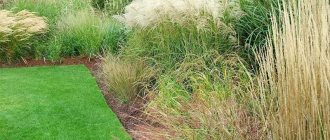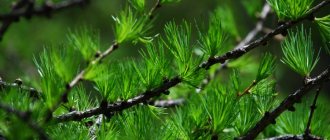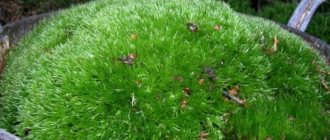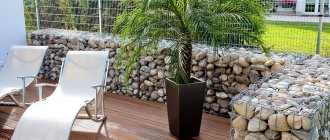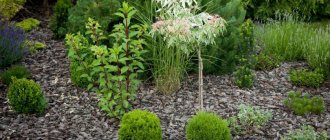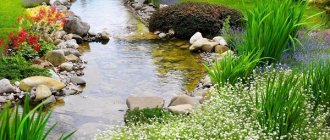Remember those times when people went to city squares or parks to admire the beauty of the fountain? Today everything has changed and you have a real opportunity to equip a structure that is magnificent in all respects on your suburban site, and you do not need to hire a team of expensive specialists to carry out installation work. This is only at first glance, it seems that arranging fountains in a dacha with your own hands is difficult and beyond your capabilities, but once you delve deeper into the essence of the task, you will understand that everything is not as expensive and scary as you thought.
fountains are a great addition to landscape design
Don’t rush to grab a shovel and run to dig a pit. In the construction of fountains, the preparatory period is important, including:
- Creation of a design project.
- Selecting the shape of the future fountain.
- Selection and purchase of materials and components.
Knowing what these structures can be like and what their main differences are will help you do everything right.
Features of the fountain arrangement
The fountain requires constant humidity and the possibility of soil erosion, so you should carefully choose the location of such a structure. Soft soil must be further strengthened by constructing a concrete base or a plateau of ceramic tiles.
It is definitely worth finding space for the location of communications that will help bring and drain water from the structure.
Why is the water in the fountain alive?
Of all bodies of water, the fountain humidifies the air most actively - because its water is constantly in motion. Moreover, as the jets rise, fall and break, the structure of water molecules changes, and negatively charged ions, which scientists call “health vitamins,” rush into the air.
They are the antipodes of the positive ions of our usual air, filled with dust and densely permeated with the radiation of modern technology, which negatively affect health and well-being. Please note: negative ions predominate in the air on the seashore and in the mountains. When a person inhales them, they penetrate the blood and stimulate biochemical processes, leading to the restoration of many structures of the body. It would be unreasonable to refuse a fountain - your own small source of living water.
Selection of necessary equipment
To make a fountain with your own hands, you will need to prepare the following materials:
- Decorative stone for frame construction.
- A ready-made plastic installation, if you decide to use such a model.
- Fountain pump to circulate water.
- Decor elements.
- A set of tools for mounting the system.
There are methods for connecting a fountain to a central water supply, but this method is not financially profitable. Therefore, it is best to use a pump: a submersible or surface version (each has its own characteristics, so the choice is up to the master).
Diseases and pests
Like many other ornamental crops, pennisetum is susceptible to diseases. Most often it is overcome by bacterial wilt and root rot. In the first case, the upper part of the plant turns gray and withers, the stems turn brown, the leaves curl, and eventually the root system dies. For treatment, use Planriz or Alrin-B. You can buy these drugs in specialized stores. Following the instructions, apply them at the root and spray the above-ground parts. If the result is zero, then remove the affected plants along with the lump.
Root rot leads to blackening of the stems and death of the plant. In this case, the affected specimens must be removed along with the root and cut off about five to seven millimeters of soil around the place where the diseased pennisetum grew. Instead of the removed soil, add ash. To prevent the problem, maintain recommended planting distances.
Spider mites and aphids are considered to be the fierce enemies of the cirrus bristleweed. Fight them using the same methods as on other plants. Spider mites can be defeated with insecticides, and first try removing aphids with a damp sponge. If this method does not help, also use insecticides.
Types of fountains
The fountain model depends on several factors:
- Number of nozzles.
- Oda spray form.
- Force of the pressure jet.
Depending on the combination of these factors, the following types of garden fountains are distinguished:
- Fountain in the shape of a bell.
- Geyser.
- Cascade fountain.
- Combined option.
In addition, depending on the location of the main bowl in relation to the ground level, submersible and open types of fountains are distinguished.
Selecting a model and equipment
Designers prefer simpler forms with minimal technical complexity. For a garden plot, such parameters are sufficient. As a rule, a powerful and high-flowing outdoor waterfall is suitable for a large fountain complex. At the dacha, you can do without a pump if a powerful rise of water is not required.
Garden fountain with flower bed around
According to the principle of operation, type of design and, accordingly, flow distribution equipment, decorative fountains for gardens can be divided into:
- cascade;
- vertical;
- circular;
- single- and multi-threaded;
- statue-shaped;
- mini fountains for the garden;
- cup-shaped, open type;
- pumping and without;
- frame, multi-level.
Fountains made from natural materials perfectly complement the beauty of a nearby flower bed or orchard. but in this case, it is recommended to make the base of the foundation at a distance from the plants in order to eliminate the possibility of waterlogging the soil and draining the device.
Square waterfall fountain design
Fountain "Bell"
The most popular option, widespread due to properties such as ease of construction and operation.
The design has one nozzle that evenly distributes the water supply under moderate pressure. Decorative finishing is possible only around the perimeter of the pond or adjacent area.
Pump systems
Pumps can be surface or subsea. The former are used for large structures, as they can provide strong water pressure.
Fountain for a cottage in Art Nouveau style
Installation of pumping equipment will require the creation of foundation pits, strengthening of walls and waterproofing of all surfaces in contact with water. To avoid possible overflow from the top of the tank, an additional drain is installed just above the edge of the normal liquid surface, preventing the water from rising above the required level.
Garden fountain with lighting
To insulate the walls and bottom of the tank, you can use a special film. After processing, all resulting seams are sealed with frost-resistant sealant. The design must be reliable and resistant to corrosion of water supply pipes and can be made of plastic.
Garden fountains made from polystone are considered the most practical.
For designs operating with a pump, an important element will be the cleaning mechanism. Careful consideration must be given to which feeding and cleaning motion principle to choose. Sometimes a durable mesh screen is installed to prevent large debris from entering. It is made from a water-resistant material such as composite decking.
Artificial pond in the garden with a fountain
Geyser Fountain
The original location of the nozzle assumes a strong supply of water without uniform distribution, so the jets are supplied in different directions with unequal directions.
Most often, the bowl is made with a high side or in the form of a well (pool), into which water is supplied.
How to treat pennisetum in winter
Without shelter, this crop can hardly tolerate severe frosts, especially in snowless winters. It is better to insulate the roots with organic matter or above-ground parts of the same plant. Therefore, after flowering has finished, do not cut the stems, as they will serve as a “blanket” that perfectly protects from the cold. It is also necessary to cover the soil around the plants. Use fallen leaves of fruit trees, dry herbs that are not affected by diseases, peat, sawdust, and pine litter. After the snow melts with the arrival of spring, the shelter is removed, and last year's stems and leaves of pennisetum are cut off at the root.
Stationary fountain
The stationary, or open version of the fountain device, is also a fairly simple option. The nozzle and water-pressure mechanism are located on the surface. Various combinations are used as decorative finishes:
- Cascading "steps".
- Garden figurines.
- Classic bowls.
There are a lot of decorative finishing options; the choice of the final model depends on the owner of the garden plot.
Project implementation and equipment connection principle
The operating principle is simple. The water that is discharged through the nozzle is collected in a container, thicket or drained into a reservoir. Then it enters the funnel, where it is cleaned during movement and enters the pipeline, after which it is distributed and sprayed using a pump.
Garden fountain decorated with carvings
The hydraulic pump is the heart of the system. It is below the waterline of the drains. Since the appliance is electric, the fountain must be within reach of the exterior cords at the pump outlet.
The main element that determines the formation of the type of flowing streams is nozzles or nozzles. The parts are organized into a tube with holes placed accordingly. Their number, size and location shape the generated water flows. Nozzles can be purchased at the store. Some craftsmen make them with their own hands.
Decorative frog fountain
Creating a water picture also includes a special source of water flow regulators. Water is poured out under pressure through nozzle holes running at right angles.
Garden fountain made of copper
The nozzle of a fountain not equipped with a pump should be installed 0.5-1 meter above the liquid level. As a result of the drop in pressure, water will be pumped out.
The distribution of pipes and nozzles depends on your imagination. Usually they place the main large nozzle as the center of the composition, and then add small thin elements.
Metal fountain for a summer residence
Construction of the fountain
The following detailed instructions will help the master in building such a complex structure in the garden. All work consists of a number of stages:
- Arrangement of the bowl.
- Pump and water supply structure.
- Decorative finishing.
Before starting work, you should decide on the location and availability of the necessary communications connected directly to the future fountain. It is also worth finding a ready-made drawing, according to which all work will be carried out.
The best partners of pennisetum
This culture gets along well with any other grains. They require minimal care, and at the same time, together they look good in one area. Choose medium-sized and tall-growing types of cereals for proximity to pennisetum. Decorative feather grass varieties are suitable: falaris canarian, oats, as well as pennisetums of various varieties. You can complement the composition with daisies, poppies, cornflowers and many other wildflowers.
When looking for good neighbors for this plant, take into account one important point. Plant annuals with annual varieties, and perennials with perennial varieties. This will make it easier for you to care for the plantings, and the area will not lose its decorative properties.
Preparing the bowl
First of all, it is necessary to clear the selected plot of land from debris, grass and stones. Then work according to the scheme:
- Prepare a trench of proper depth (depending on the type of fountain). When preparing a pit, you need to focus on external markings.
- The next stage is leveling the walls of the pit.
- Laying a sand cushion on the bottom. The sand layer should not be less than 5-6 cm, and after laying it must be thoroughly compacted.
- Next, a fairly strong film is laid on the bottom, the edges of which extend beyond the boundaries of the trench. The edges are secured with weights so that the film does not interfere with further work.
- A sufficient amount of gravel or crushed stone is poured on top of the polyethylene in the form of a thin layer.
- Now you need to install the pump itself. Any plastic bucket of the required volume is perfect, but it needs to be slightly modified: several holes are made along the surface using a drill.
- The finished base is installed at the bottom of the trench and must be leveled along the horizontal axis.
The preparation is completed by forming a side of two or three rows of large stones that limit the bowl and edges of the pit.
Pennisetum care
The soil should be loosened as often as possible and weeds should be removed. Protect the plant from cold, strong winds and excess moisture. Watering is recommended only during periods of drought. Make sure that the plant does not fall into an area of heavy shading.
Too dense soil must be loosened well before planting and subsequently weeded periodically. In summer, the plant needs rare fertilizing with organic and mineral fertilizers, but only if you planted this plant on depleted soil. Use liquid formulations enriched with minerals. During the growing season, apply complex fertilizers once a month.
Follow the watering rules. If it rains at least occasionally in the summer, then Pennisetum will have plenty of natural precipitation. But during dry periods, it is necessary to pick up a watering can or hose. Water so that water does not stagnate in the soil.
Fountain device
Now we need to consider how to install the pump and water pressure system:
- A little crushed stone is poured into the bottom of the bucket, in a layer of about 7-9 cm.
- A pump is installed inside. It is important to ensure that there is free space inside the container - this will significantly increase the service life of the pump.
- A wire from the pump is drawn from a bucket along the bottom of the pit (necessarily without tension, lying freely on the gravel).
- If the wire insulation does not meet the standards, it must be improved. The wire will be in constant contact with water, which means it is necessary to protect the inhabitants of the garden plot.
- The entire structure (pump and water collector) is reinforced with stones from above so that only the nozzle remains on the surface.
- All that remains is to connect the pump: the shield is placed in a place inaccessible to moisture and children, and the wire is connected. When running the cable along the ground, lay it in a layer of soil to a depth of 7-9 cm.
These instructions are universal for all fountains with bowls; only small details may differ.
Country fountain: choice of materials
To create a strong and durable fountain that can delight you for several years, you need to use wear-resistant materials that have excellent performance characteristics. As practice shows, most summer residents use polystone for these purposes - an artificial stone based on acrylic resins, aluminum hydroxide and crushed natural stone. The material completely imitates natural stone, but has an affordable price that does not affect its excellent characteristics (resistance to fading and sunlight, temperature changes and mechanical damage).
Also, to build a fountain you need to buy a drainage system made of expanded clay or plastic. Both materials have a long service life and high strength. If a large stationary structure is being created, then it is better to use a more expensive material - polymer concrete. As for small country fountains, for their arrangement you can use not only expensive, but also improvised materials (ceramics and tiles, old car tires and steel pipes).
Decorative decoration of the fountain
Exterior decoration can be done in absolutely any style you like. The most interesting ideas today are:
- Finishing of the outer frame with original brickwork.
- Laying with plaster stones on the outer wall.
- Decorating the adjacent wall in the form of frames with candles, flower pots or tiers of stairs.
If you wish, you can see photos of finished garden fountains in any landscape design magazine.
Differences and advantages of designs
Almost all designs of garden fountains are simple in form and operating principle. An open fountain will work by creating a differential pressure of the liquid. To do this you will need a large container filled with water.
When using circular style water distribution without a pump, it is not enough to install a suitable nozzle; you will need a whole list of parts to create the circulation. It is important to note that the device can operate quite stably without human intervention. Water from the lower level supplied to the nozzle forms a continuous closed circular system. Each time it is ejected through the nozzle and collected in the tank. After passing through the drain hole, it enters the channel. After the coarse and fine cleaning stages, the liquid is pumped back through the pump and sent to a new cycle.
Round country fountain
The disadvantages of this design include the presence of an open surface to maintain the liquid level and maintain low pressure. In addition, the exposed surface of the water can become clogged with dust and debris, especially in windy weather.
Fountain for a summer house from old watering cans
If your dacha already has a water area, then a fountain with a pump will perfectly complement this picture. But for installation, you will need to perform a complex of complex works: lay pipes along the bottom, install a solid foundation for the pump, think over the connection to the electrical network and make the wiring of the nozzles.
Interesting design ideas
Today you can find very original designs in the arrangement of garden fountains:
- Decorative fountain made of bamboo. Features: strength of the material, its resistance to moisture and deformation, miniature size and low water supply pressure.
- Fountain on the wall. The pump is placed either in construction niches or at the bottom of the pool, where water is supplied. Various garden figurines are used as decorative decoration.
- Pond fountain.
- Fountain made of plastic bottles. It is not at all necessary to spend huge amounts of money on purchasing garden figurines or material for forming a cascade. If you have limited financial resources, you can use a regular bottle to create jets. Before practical use, it must be decorated.
Plants to decorate a fountain or pond
In the last article we looked at how to build a fountain on a personal plot. As promised, in continuation of the material about the fountain, we will talk about what plants can decorate our fountain or pond in the country. After all, just water and stones are boring, you’ll agree. And the question of which plants should be planted near a fountain or pond is very important, because not all flowers are loved if there is too much water and dampness. In order for the ecosystem near our pond to be balanced and the water in the pond to be always clear, we need to plant plants that will improve the soil around the pond and purify the water from unwanted microorganisms. Urut and pondweed are just such plants. They feed on substances that are dissolved in water, making it impossible for algae to grow rapidly. This way we will not allow the water in our pond to bloom.
On the surface of the water you can plant stunning plants with floating leaves, such as salvinia or aponogeton. They will also perform the function of purifying water in a fountain or pond by providing shade to the bottom of the reservoir, because, as is known, the sun promotes the formation of chlorophyll in algae.
As in any business at a summer cottage, creating a beautiful landscape around and inside a reservoir does not require fuss and haste. Sketch a sketch of your future flower garden arrangement, look at how your neighbors’ pond or fountain is arranged, look through thematic magazines, and “dig” on the Internet. When planning your flower garden, think about viewing angles. Typically, smaller plants are planted in front and larger ones in the back. If we do everything the other way around, large plants will eventually cover small ones, which will spoil the overall appearance of our pond or fountain. That is, plants need to be planted like a ladder. From small to large. In addition, you need to consider the spacing between plants. If you plant them too closely, you will have to constantly thin them out. And the plants near the pond grow very rapidly, you won’t have time to look back.
Another aspect that cannot be ignored is the landing depth. Roughly speaking, your pond consists of several zones. Deep zone (place at the maximum depth of the reservoir), shallow water (zone near the shore), marshy soil (edge of the shore) and dry soil. We strongly recommend that you consult with a specialist or sales consultant in the store. You should get an answer to the question of which plants are suitable for all of the listed zones. If you make a mistake, your plants will die, the process of rotting will begin and the pond will simply have to be replanted with plants.
Now about the most common plants for each of the above zones. In the deepest place we will, of course, plant water lilies (scientifically, nymphs). One note, these plants love sunlight, so the center of the pond or fountain should be open to the sun. Further from the center you can plant lilies. They also love the sun and this must be taken into account. In the swampy area, irises, mint, rush plants or cereals, which love moisture, are usually planted.
Near the shore in dry soil, try planting chastuha, brush-flowered snorkel, calamus iris, ponytail or arrowhead.
Photos of garden fountains
Total
Category: Small architecture
The last stage is checking and finishing
Having finished installing and connecting the pump, pipes and distribution nozzles, you need to make sure the system is working. And only after checking that everything functions correctly as intended, you can begin to decorate the pump and bowl.
The device will work correctly with precise and correct assembly and proper connection of the electric pump. The main impression is made not so much by the design of the structure as by the appearance of rising jets, sparkling and running streams.
Fountain for a summer residence, decorated with a tub of flowers
If you do not check the functionality of the system, subsequent dismantling to correct deficiencies will create many problems.
Garden fountain
Photo gallery - fountains in the country
Take your time with your choice. Give the image a chance to form. Time will decorate it with beautiful accessories and additions, but if the image still turns out to be a little blurry, then use the photo gallery. This is the only correct solution that will significantly save time and find exactly what worries you so much, but has not yet taken shape in the final image.
A small fountain decorating the area in front of the house
Owners of small plots who want to install fountains can be advised to pay attention to modest fountains that do not take up much space, but at the same time create comfort and a special atmosphere of a secluded place, without which you would like to have a place in your garden where you can relax your soul and restore strength.
A decorative fountain should be proportionate to the site
Any fountain, even the most modest in size, can become a bright decoration of a suburban area
When installing a small fountain, you should remember a few simple rules that will make it possible not to spend a lot of time maintaining the structure.
- Try to install the fountain bowl so that leaves from the trees do not fall into the pond, so that the drains and filters do not become clogged. This way it will last longer.
- When installing the fountain, try to do it on a level area. The water level in the bowl must be constant; this is important for the full functioning of the pump.
- The fountain should be located at a sufficient distance from the entrance to the house so that in windy weather the stream of water does not fall on the porch steps or walls of the house.
- Small fountains can be decorated with a variety of plants and additional decor, which will diversify the interior look and create a special atmosphere.
Once the decision has been made to install a fountain in the garden, the main thing is to make the right choice and not go overboard with the size of the object and stay within the framework of the stylistic decision that dominates your estate. Then you will know exactly where to go to recuperate and relax, breathing in pleasant coolness in the summer heat.
Fountains come in different levels of complexity and types

